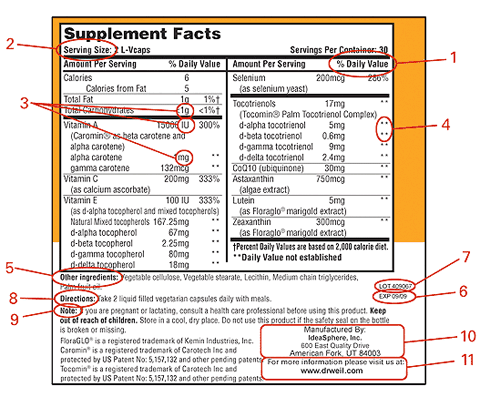How To Read A Vitamin Label

Labels on natural vitamin supplement bottles present a challenge to manufacturers: a great deal of information about a complex product must be squeezed into a tiny space. Through necessity, they resort to abbreviations and verbal shorthand to communicate, and it can be a bit daunting to the uninitiated. Here’s a guide to sorting it all out:

If the “% Daily Value” listed is “75%” that means one serving supplies 75 percent of the entire DV for that nutrient. If the value listed is more than 100 percent, it suggests some advantage to exceeding the DV. In this case, it reflects the view of Dr. Weil and his science advisory board that the DV established by the FDA is below the optimal dosage. This illustrates the difference between “what you can get by on” and “what is the amount that may provide the most benefit.”
2. “Serving Size”: This indicates how many of the units – tablets, soft-gels, capsules, etc. – need to be consumed in a day to reach the percent of daily value listed on the label.
3. Units of measure reflect the standard reference units for each kind of nutrient. “I.U.,” stands for “International Unit” and is the standard for measuring fat-soluble vitamins, which include vitamins A, D, E and K. The abbreviation “mg” stands for milligrams, or one-thousandths of a gram, and “mcg” stands for micrograms, or one millionths of a gram.
4. Double asterisks in place of DV listings mean that DVs have not been established for these nutrients. The nutrients are included in some Weil dietary supplements because studies suggest they have scientifically validated health benefits and are safe to consume at the amounts contained in the supplement.
5.“Other ingredients”: This is a list of compounds that do not directly contribute to the nutrient DVs in the supplement, but instead aid in functions such as tablet integrity, proper digestion or preservation of shelf life.
6. “EXP” indicates the expiration date; that is, the date by which the supplements in the bottle will have degraded to the point that the percent of DV listed on the label is no longer accurate. Consuming supplements that are past their expiration date is usually not harmful, but since the full nutritional value is not received by the consumer, it is recommended that supplements that have passed their expiration date be replaced with fresher ones.
7. “LOT” is a number that identifies the specific manufacturing lot that included this particular item. It is useful in the unlikely event that questions arise about the integrity of ingredients or manufacturing processes used to create that lot.
8. “Directions” provides information to help the consumer safely obtain maximum value from the product.
9. “Note” serves to warn consumers of potential adverse effects the supplement could present to individuals such as pregnant or lactating women, people taking certain prescription medications, or people with allergies. This section also contains information regarding how to store the supplements.
10. Manufacturer’s information tells which company made the supplement, and where the company has its headquarters.
11. “For more information” provides contact information should purchasers or potential purchasers have questions about the product.














